HINTS OF SPRING, REMEMBRANCE OF SUMMER
/12 Comments/in Flowers, Gardening, Planning, Vegetables/by Lee Reich
Greenery, For Humans And Ducks
Spring has come early, as usual, in my greenhouse. Growth is shifting into high gear as brighter sunlight fuels more photosynthesis and warms the greenhouse more and for a longer time each day. Giant mustard plants, which provided greens all winter, are no longer tasty now that they have shifted their energy to stalks topped with yellow flowers. No matter. I’m digging the plants out and sowing lettuce seeds.
Paths in the greenhouse are carpeted in green — mostly from weeds, mostly chickweed, which is also soaking up the sun’s goodness. No matter. I’m also digging these plants out before they go to seed and threaten takeover of the greenhouse.
To take over the greenhouse, the chickweed would have to do battle with claytonia, which already has self-sown to bogart much of the greenhouse floor. Fortunately, the claytonia is good fresh in salads.
Chickweed is also good — to some people — for eating. But not for me. My ducks, however, love the stuff. So it’s a win-win situation. I weed the greenhouse paths, gather together a pile of chickweed, then throw it to the ducks as I walk past them on my way back to the house. They rush over to reach it soon after it hits the ground, gobbling it up at a frantic (for a human) pace. Good thing they don’t have to chew.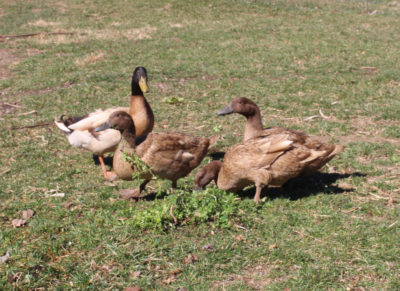
The ducks also enjoy the flowering mustard plants which, along with the chickweed, transmute into delicious duck eggs.
Bottled Summer Goodness
A couple of weeks ago I finished off the last of the elderberry fruit syrup I made this past fall. No fruit could be easier to grow than elderberry. In just a couple of years, the bushes have grown to enormous size, their clusters of creamy white flowers bowing to the ground at the ends of stems late each spring. Later in summer, those flower clusters morph into blue-black fruits, which, admittedly, aren’t very flavorful plain (and shouldn’t be eaten raw).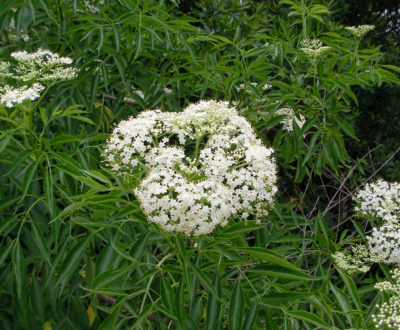
The only care I’m planning for my plants is to prune them every year or so. Pruning will entail cutting some of the older stems to the ground to make way for younger, more fruitful stems, as well as shortening any branches that arch down so much that their fruit would rest on the ground.
In summer, I stripped the ripe fruits from their clusters into a half-bushel basket, and, postponing what to do with them, froze them. Come fall, I cooked them in a little water, added some maple syrup, crushed them with a potato masher, and then jarred them up.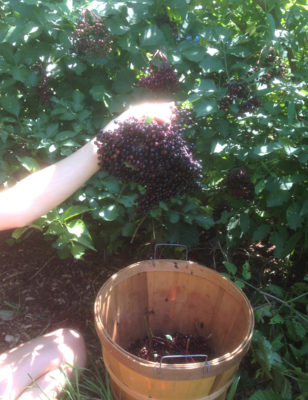
Why all this trouble for a fruit that’s not very flavorful? Because the berries are so healthful! Studies have shown them, or their extracts, to be “supportive agents against the common cold and influenza.” Other benefits have also been ascribed to use of elderberry, but common cold and influenza are enough for me.
Now that I’m out of elderberry syrup, I already feel a slight cold coming on.
Timing Is Important
Back to the greenhouse . . . and sowing seeds of the cabbage family (Brassicaceae), also called crucifers. Which gets me thinking back to last fall when a friend was bemoaning the lack of fat sprouts and the puny growth of his brussels sprouts plants. I asked when he sowed the seeds. “Back in early August,” I think he said. At any rate, back in summer.
It’s no wonder he wasn’t going to be harvesting brussels sprouts. The plants need a long season to mature, from 90 to 120 days, depending on the variety. For best yields, this means sowing seeds now, growing them as transplants for about 6 weeks, and then planting them out for harvest that will begin in late summer. At the very least, the seeds could be planted directly in the ground in a few weeks.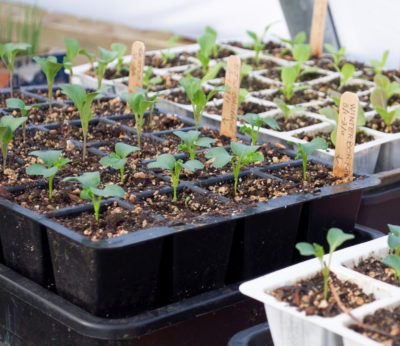
I’m sowing other crucifers now, not because they need such an inordinately long growing season, but so that they can be harvested in late spring and early summer. First harvests will be of miniature bok choys, and then cabbages and, if I grew them (I don’t), broccoli and cauliflower. Kale is the most versatile member of the family — and the one I grow in greatest quantity — amenable to sowing anytime from now until later in summer for harvest in late spring, through summer, and on into fall and winter.
Mustard, turnips, and arugula are also crucifers, the whole family most easily identified by their four-petaled blossoms in the shape of a cross, the root of the word crucifer.
IT’S SPRING! INDOORS, AT LEAST
/3 Comments/in Flowers, Fruit, Gardening, Houseplants/by Lee Reich
A Big, Fat, Red Flower; Perfect For Now
One spring day many years ago, my friend Bill looked out upon the daffodils blooming and other stirrings, and summed up the scene with the statement that “It’s spring and everything is wigglin’.” We haven’t yet come that far along, but things are wigglin’ — indoors. (Little did I know that 2 days after writing this, all would be buried under two feet of snow!)
Most dramatic among the wigglins is the big, fat flower bud pushing up from the big, fat amaryllis bulb. True, the goal of most people is to have the flamboyant, red blossoms open for Christmas, which requires beginning a bulb’s dormant period in the middle of August. It’s cool temperatures, around 55°F., and dry soil that puts an amaryllis bulb to sleep. Then, in early November, warm temperatures and just a little water wakens the bulb out of its slumber, with increasing watering, commensurate with its growth, bringing the bulb fully awake and ready to burst forth in bloom 6 weeks later.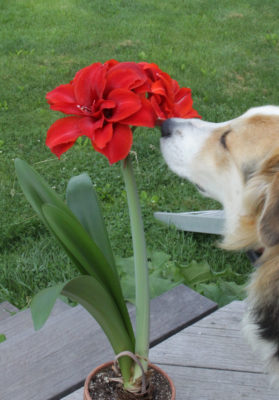
In mid-August, I’m more focussed on harvesting tomatoes and peppers, readying endive for October harvests, making compost, and other garden goings-on than on the amaryllis bulb that I tipped out of its pot and planted in the ground in late spring. And anyway, a few red flowers, even flamboyant ones, do little to counteract December’s grayness.
So I let my amaryllis flower in its time, which should be within a couple of weeks or so, and add to the indoor late winter wrigglin.
Citruses Come Awake
Much more exciting are the less dramatic signs of growth on some of my potted subtropical trees.
As subtropical plants, citrus trees push out multiple flushes of growth through the year. The first flush is about to begin on Meyer lemon, Golden Nugget mandarin, and Meiwa kumquat.
One or more of those citrus flushes also bears flowers, which lead to fruits. The kumquat typically flowers late. My Golden Nugget mandarin hasn’t yet ever flowered for me, so I’m not sure when to expect those blossoms. Wait! Do I see the tiny beginnings of a flower bud on that nascent stem?
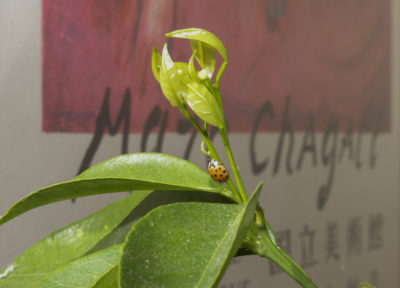
Golden Nugget awakening
Meyer lemon is notorious for its free flowering. Looking closely, I see that some of the new growth includes flower buds. At the same time, I see that the lemon fruits that had their beginnings last year are now swelling more rapidly. I’m predicting to have new lemons forming even as I am harvesting ripe ones.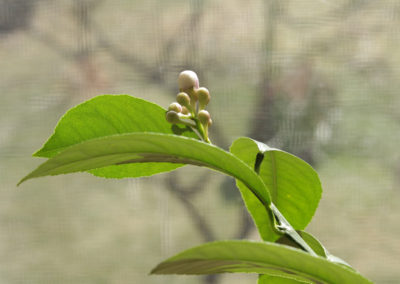
Fresh-picked Avocados, in New York?
Most exciting are the fat buds expanding on my potted avocado tree, grown from a seed I planted a couple of years ago. I grafted this seedling with a stem of the Marcus Pumpkin variety of avocado that I got about this time last year from a friend in Florida.
An avocado tree grown from seed would take many years — if ever, as a houseplant this far north — to reach maturity, that is, to be old enough to be able to flower and fruit. A stem taken from a fruiting plant is already mature, though, and remains so even if grafted on a young seedling. The grafted stem of Marcus Pumpkin on my avocado tree is, in fact, about to burst into bloom.
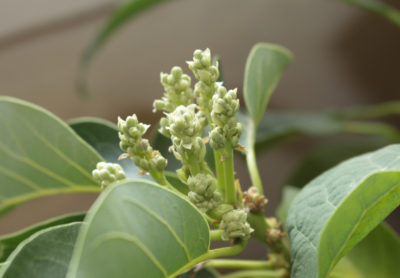
Avocado flower buds
Much can happen ‘twixt the bloom and the mouth; I’m guardedly hopeful to be guacamole-ing freshly plucked avocados in a few months. The problem is synchronous dichogamy, which may end up being more of a mouthful than my avocado fruit. The upshot of this mouthful is that each of an avocado plant’s gazillion flowers stays open for 2 days. When the flower first opens it is in the female phase, receptive to pollen; this phase lasts 2 to 4 hours. Day 2 has the flower in its male phase, shedding pollen. The male and female flower parts being out of synch is good for avocado evolution but bad for me as far as home-grown gucamole.
Depending on the variety, avocado flowers might be Type A or Type B. Type A flowers are not ambitious, competitive, or impatient like Type A humans. Or maybe they are, because the female parts are open and receptive only in the morning of the first day; these same flowers open as males in the afternoon of the second day. Type B flowers aren’t ready for action until the afternoon of their first day; then they open a males the next morning.
The upshot of all this is that it’s best to have two different avocado varieties, a Type A and a Type B. The morning phase of Type B, as males, can pollinate the morning phase of Type A, which are females. And vice versa.
Marcus Pumpkin is a Type B avocado. When I grafted it, I also grafted Lula, a Type A avocado, on another seedling. Although Lula failed to take, all may not be lost. My plan is to dab the Marcus Pumpkin flowers in the afternoon with an artist’s brush, tap the pollen into a petri dish, cover it, and the next morning dab the brush from the collected pollen to the Marcus Pumpkin flowers in their female phase.
Perhaps I’ll be harvesting fresh avocados in a few months. Perhaps I’ll be just buying fresh avocados in a few months. At any rate, as a northern gardener, it’s very exciting to have my avocado tree about to flower.
And Even Hints Of Spring Outdoors
All is not so quiescent outside. After a couple of warm days, I see that winter aconites have spread their cheery, yellow petals. (But not for long.)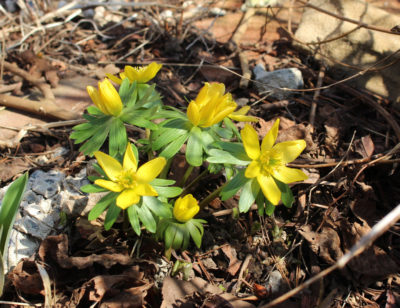
‘SHROOMS
/7 Comments/in Gardening, Planning/by Lee ReichHome-Grown Oysters
Move over shiitakes, you fancy, reputedly healthful mushrooms offered on supermarket shelves and at farmers’ markets at high prices. Make way for oyster mushrooms.
Many of us have chosen to grow shiitakes rather than pay the high prices for them. This means laying in a stock of freshly cut hardwood logs and riddling them with holes that are plugged with inoculated dowels pieces, then sealed with wax. A dose of patience is also needed for home-grown shiitakes, even after going through all that trouble, because a year is needed until first harvest.
My logs, from two and three years ago, yielded mushrooms last spring and autumn. But those logs are sleeping now; what about mushrooms now?
Enter oyster mushrooms. Oyster mushrooms are much more cosmopolitan about their nourishment. And planted now, harvest could begin within a few weeks.
The basics of growing any mushroom are the same. You inoculate a substrate (some material high in cellulose) with purchased or home-grown mushroom spawn. Fungal threads colonize the substrate and then, after a certain amount of time or in response to some stimulation, such as being dunked in water, mushrooms pop out of the surface of the substrate. In between short rests, they’ll pop out repeatedly until the substrate is exhausted. Then you start again with a new inoculation.
Toilet Paper Mushrooms!?
A few years ago, I grew oyster mushrooms on nothing more than a fresh roll of toilet paper, which provided a conveniently configured source of cellulose. I got the spawn for inoculation from Field & Forest Products (their TeePee™ kit). All that’s needed is to pour boiling water over a roll of fresh toilet paper, let excess water drain off, then put the roll into the plastic bag that is provided.
I inoculated, as directed by filling the center tube with the mushroom spawn and sealed the bag closed. Every once in a while I opened the bag to mist the inside with water, and watch the fungus grow its way out into the paper. After colonization is complete, mushrooms started popping up from the top of the roll.
Okay, my wife did express some aversion to eating food growing out of toilet paper. And the whole setup, admittedly, is not really all that attractive.
Coffee Grounds, Another Substrate
Not to give up on winter mushrooms, I could try growing oyster mushrooms on another readily available substrate: coffee grounds, a waste product from coffee shops, bakeries, and fast food joints. I also remember a previous foray into “espresso mushrooms” a few years ago. The Pohu strain of oyster mushrooms are among the best for coffee grounds.
To inoculate, you just break up and mix the spawn, a compressed mass mixed with sawdust, with (clean) hands and/or a knife in with the coffee grounds. The mixture then goes into a (clean) bucket having drainage holes, which, after a thorough watering, is covered with the plastic bag
After sitting in a bright location and misted daily, the coffee grounds becomes covered with fuzzy, white fungal threads. Within a few weeks, fat mushrooms swell up from the substrate, ready for harvest when their caps become just concave.
In my previous experience with espresso mushrooms, I remember an invasion of fruit flies having a field day on and in the coffee grounds. Or were they fungus gnats? Avoiding overwatering should keep fungus gnats in check, and fruit fly season is past, so espresso mushrooms are worth another try.
The nice thing about growing oyster mushrooms on coffee grounds is that there’s no need to purchase new spawn when production slows. A nice chunk of the exhausted coffee grounds can be used to inoculate some fresh grounds.
The cleaner everything that comes into contact with the spawn and the substrate right from the start, the less chance for contamination and the longer the process can be kept going. It can become an indoor game, to see how many oyster mushroom cycles can be grown before new spawn is needed again. In addition, of course, there’ll be some tasty harvests.
An Early Spring, For Shiitakes
Now that I think of it, I could be sitting down to a meal with fresh shiitakes — just fool some logs into thinking it’s spring. Which it is, in my greenhouse. I’ll move a couple of logs in there, where I’ll bet the warmth and high humidity will soon pop out some mushrooms.

